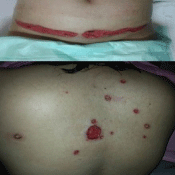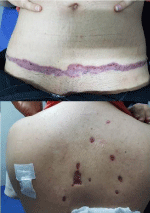Keywords
A 36-year-old woman, who had a 4-year history of refractory surgical site dehiscence after cesarean section, presented with backskin ulcers. Examination revealed dehiscence of transverse cesarean scar along with some painful punched out lesions on the back with diameters ranged from 2 to 20 millimeters (Figure A). The lesions were reported to primarily appear as an inflammatory vesicle and then, after local skin manipulation, rapidly break down to form an ulcer. Skin biopsy was performed and result of histopathologic evaluation was consistent with pyoderma gangrenosum (Figure B). A focused review of the patient’s history found intermittent peripheral joint swelling and inflammatory low back pain for some years. Upper and lower gastrointestinal endoscopy were normal. Magnetic resonance imaging study revealed active sacroileitis that confirmed the diagnosis of ankylosing spondylitis. Treatment with methotrexate and infliximab was started and significant clinical response was achieved during hospitalization (Figure C). After 3 months of clinical follow-up, the skin lesions were nearly totally resolved.
Pyoderma Gangrenosum (PG) is a neutrophilic dermatosis that usually presents as ulcerative skin lesions with potential exacerbation after traumatic insults. Although the exact mechanism for development of neutrophilic dermatosis as PG is not clear, dysregulation of the innate immunity and abnormal function of neutrophils have been considered as primary factors contributed to its pathogenesis [1]. More than half of the patients with PG have an underlying systemic disease such as hematologic disorders, inflammatory bowel diseases, or inflammatory arthritides such as rheumatoid arthritis and ankylosing spondylitis [2]. The background associated disorder may be diagnosed before or after PG and the clinical course of PG is not always parallel to its associated condition [3].

Figure A:

Figure B:

Figure C:
References
- Adachi Y, Kindzelskii AL, Cookingham G, Shaya S, Moore EC, Todd RF, et al. Aberrant neutrophil trafficking and metabolic oscillations in severe pyoderma gangrenosum. J Invest Dermatol. 1998; 111: 259.
- Binus AM, Qureshi AA, Li VW, Winterfield LS. Pyoderma gangrenosum: a retrospective review of patient characteristics, comorbidities and therapy in 103 patients. Br J Dermatol. 2011; 165: 1244.
- Ahronowitz I, Harp J, Shinkai K. Etiology and management of pyoderma gangrenosum: a comprehensive review. Am J Clin Dermatol. 2012; 13: 191.
